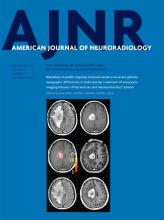Abstract
BACKGROUND AND PURPOSE: Collateral flow is associated with clinical outcome after acute ischemic stroke and may serve as a parameter for patient selection for intra-arterial therapy. In clinical trials, DSA and CTA are 2 imaging modalities commonly used to assess collateral flow. We aimed to determine the agreement between collateral flow assessment on CTA and DSA and their respective associations with clinical outcome.
MATERIALS AND METHODS: Patients randomized in MR CLEAN with middle cerebral artery occlusion and both baseline CTA images and complete DSA runs were included. Collateral flow on CTA and DSA was graded 0 (absent) to 3 (good). Quadratic weighted κ statistics determined agreement between both methods. The association of both modalities with mRS at 90 days was assessed. Also, association between the dichotomized collateral score and mRS 0–2 (functional independence) was ascertained.
RESULTS: Of 45 patients with evaluable imaging data, collateral flow was graded on CTA as 0, 1, 2, 3 for 3, 10, 20, and 12 patients, respectively, and on DSA for 12, 17, 10, and 6 patients, respectively. The κ-value was 0.24 (95% CI, 0.16–0.32). The overall proportion of agreement was 24% (95% CI, 0.12–0.38). The adjusted odds ratio for favorable outcome on mRS was 2.27 and 1.29 for CTA and DSA, respectively. The relationship between the dichotomized collateral score and mRS 0–2 was significant for CTA (P = .01), but not for DSA (P = .77).
CONCLUSIONS: Commonly applied collateral flow assessment on CTA and DSA showed large differences, indicating that these techniques are not interchangeable. CTA was significantly associated with mRS at 90 days, whereas DSA was not.
ABBREVIATIONS:
- CS
- collateral score
- IAT
- intra-arterial therapy
- MR CLEAN
- Multicenter Randomized Clinical Trial of Endovascular Treatment of Acute Ischemic Stroke in the Netherlands
- © 2016 by American Journal of Neuroradiology












